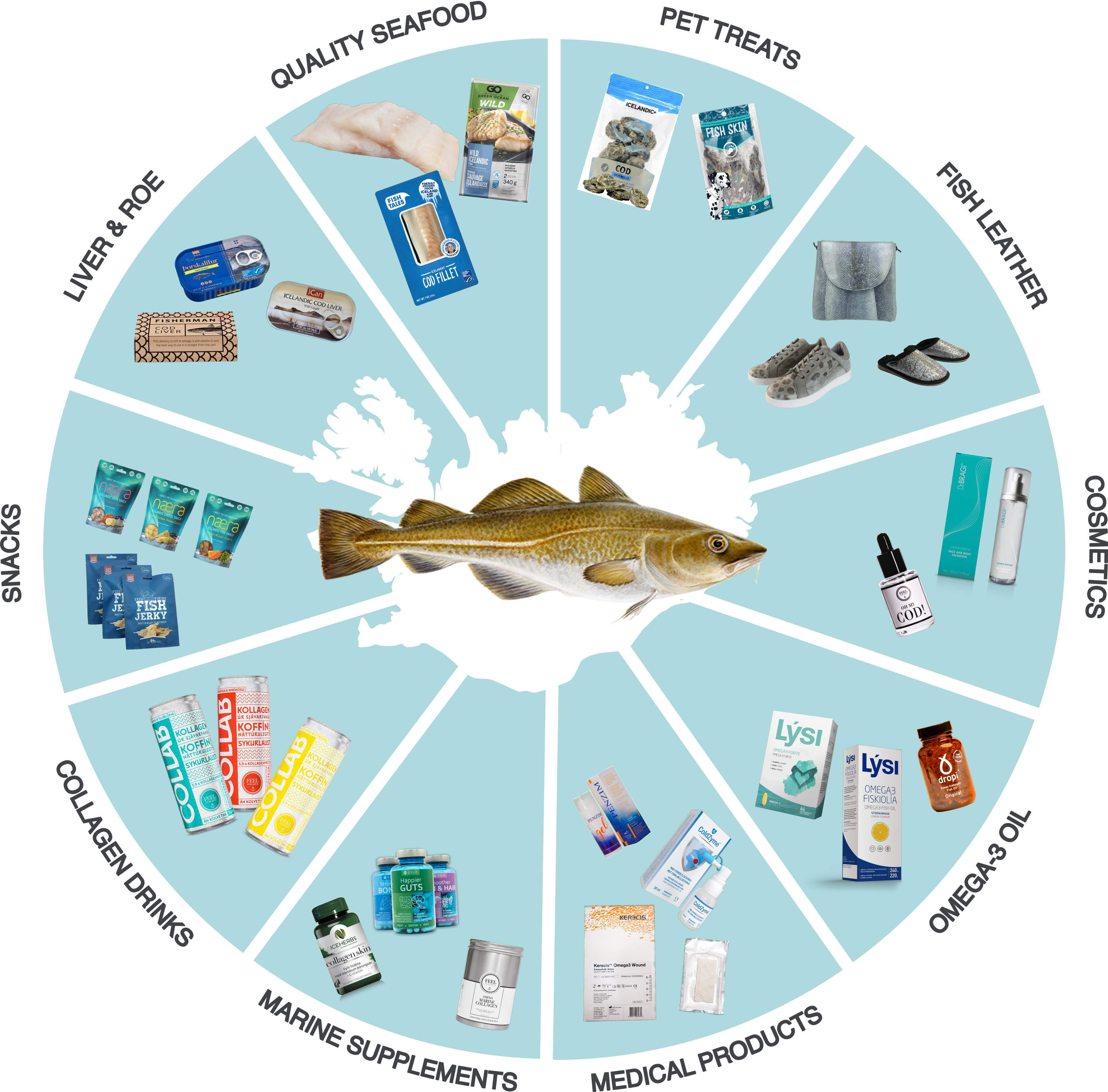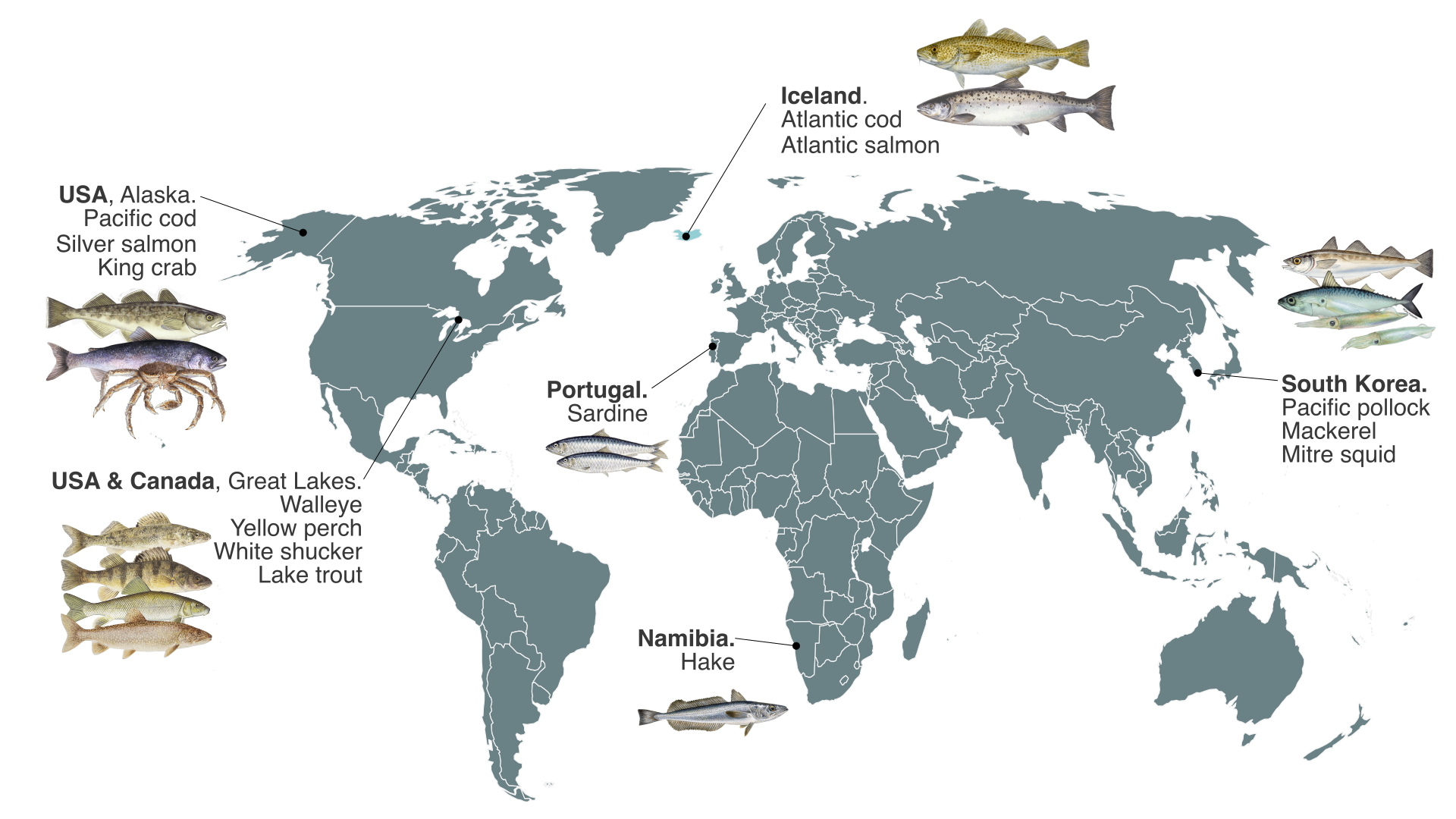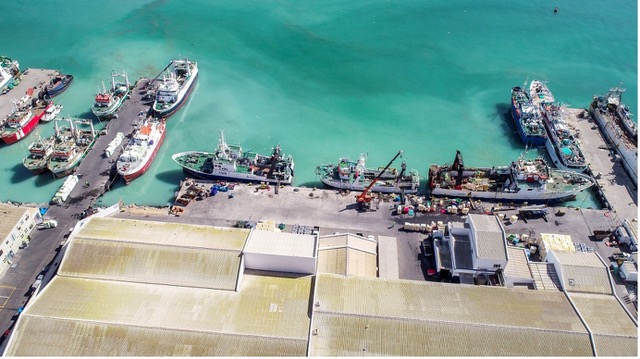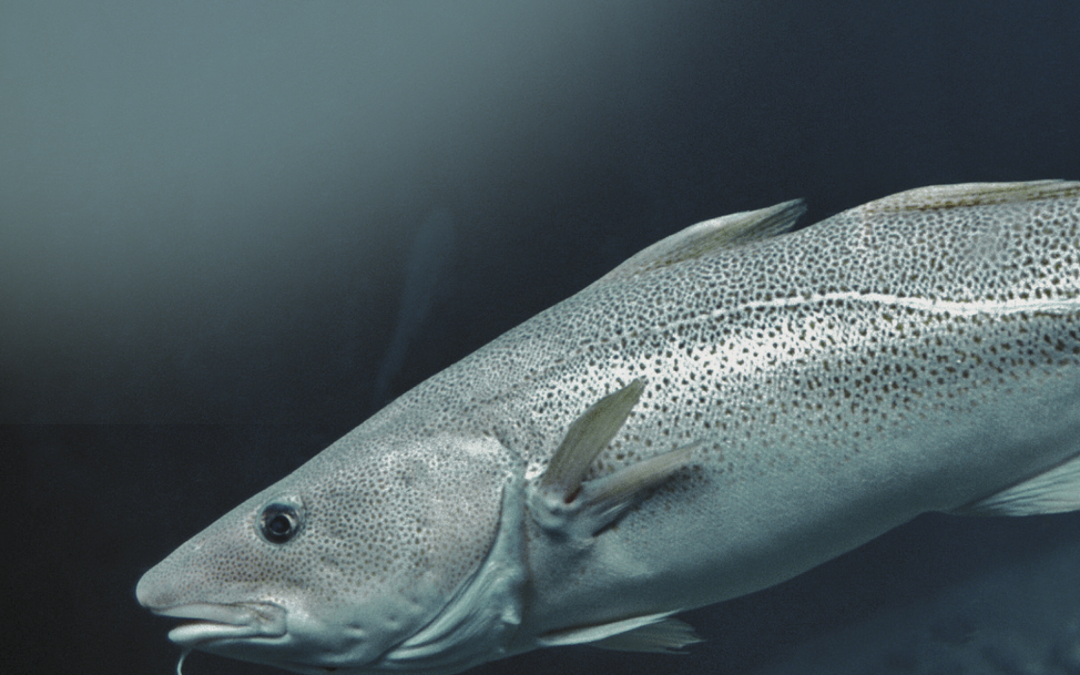
Prepared by Thor Sigfusson, Alexandra Leeper, Clara Jégousse and Melanie Siggs.
Highlights
Unprecedented value from Cod
Iceland has successfully transformed a single Atlantic cod from around $12 to $5000 by find value creation opportunities from every part of the fish, across a wide range of value chains and driven by cross-sectoral collaboration.
A 100% fish framework mapped
One size does not fit all when it comes to the international seafood sector, and by working with domestic and global partners, the Iceland Ocean Cluster has developed a framework that can be adapted to support fisheries and aquaculture organisations to reach their full utilisation goals.
100% fish is growing globally
There is exciting activity happening all over the globe, adapting the Icelandic 100% fish model to different countries, different seafood species and different markets. Some examples include Hake in Namibia and Tuna in Walleye in the North American Great Lakes.
The 100% Fish programme
A successful 2023 is fuelling the next steps for seafood value creation in 2024.
The 100% Fish programme is maximizing the value of every part of the seafood we catch and farm while striving towards zero-waste. This annual summary will provide details on the latest activities of the 100% Fish programme.
Approximately 10 million metric tonnes of targeted, commercially caught fish are wasted every year. This waste primarily consists of cut-offs from processing, heads, frames, guts, skin, and scales – which are often thrown back into the ocean where they interrupt marine food webs or they are thrown to landfills, where this organic material breaks down, releasing methane, a potent Green House Gas (GHG). As the global aquaculture sector grows, it generates additional side streams from processing that add to the total volume of seafood currently wasted and further contributing to the global carbon footprint associated with food waste.

By creating novel value chains, functional businesses, and products that sustainably and profitably use all parts of the fish, this creates incentive toward full utilisation, and it supports key United Nation Sustainable Development Goals, such as 14 – Life Below Water and 12 – Responsible Consumption and Production. The impact of the saved waste in Iceland has been huge – for Atlantic cod now, 90% of every fish is utilised instead of wasted and significant value has been created: supporting a win-win for environment and economy with a single fish once valued at $12 to one with a potential value of over $5000 – with new socially beneficial products provided to the market.
A Global Challenge
The Iceland Ocean Cluster (IOC) was established in 2011 with the aim to strengthen relations between different parts of the seafood industry; the classical ones like the fishermen and processors, and the „new“ seafood industry; startups and R&D taking the seafood industry to new heights. Early on, the full utilisation of seafood became the main emphasis of the IOC on a global scale. The reason was simple: 10 million metric tonnes of waste – rarely talked about in the global arena!
The initial impact of the 100% Fish movement has been seen in Iceland where it originated – driving a complete change in the narrative around seafood – where side streams are no longer thought of as waste but as an economic and biological resource. Atlantic cod, once primarily valued for its fillet (constituting 45% of the fish) and often poorly handled, has been transformed into a resource where over 90% of the fish is used (including the heads, skins, bones, guts, and cut-offs) to create a wide range of commercial products across sectors, e.g., food, feed, cosmetics, nutraceuticals, textiles, and even biomedical applications.
Scaling solutions in the seafood sector presents a significant challenge due to its complexity. One of the most significant obstacles is the lack of comprehensive mapping for seafood waste from both fisheries and aquaculture. Information such as the volume, nutritional and functional characteristics of these side streams, and where the biomass is discarded needs to be collected for each case to carry out value chain analysis and build viable and sustainable business cases.
The 100% Fish programme has successfully developed a framework for conducting comprehensive mapping. This process allows for the identification of easily attainable product solutions in new cases, as well as addressing the challenge of matching the volume of seafood by-products with scalable and viable solutions.
Furthermore, the programme recognises that a one-size-fits-all approach is not feasible due to issues such as supply chain complexity and lack of infrastructure. It is essential to tailor solutions to specific contexts. To overcome the issue of limited collaboration, 100% Fish uses clustering and mutual gains benefits to enhance connectivity.
While the initiative focuses on maximising the use of each fish, it depends on the health of these marine resources. Restoring and preserving wild fisheries is fundamental. The success of the 100% Fish programme relies on well-managed fish stocks and aquatic ecosystems, such as those stocks certified by the Marine Stewardship Council (MSC).
Around the World

The 100% Fish programme is making a global impact, extending its reach to new countries and seafood species. In the Great Lakes region of the United States and Canada, where 50% of the commercial catch volume was previously destined for landfill, the programme has catalysed a regional initiative led by the Great Lakes St. Lawrence Governors and Premiers (GSGP). Today, 18 regional companies have signed the „100% Great Lakes Fish“ Pledge, committing to using 100% of each commercially caught Great Lakes fish by 2025. Comparable work is now being explored in Alaska for commercial fisheries where huge volumes of seafood are going to waste. The Pacific Islands Ocean Cluster, have a regional 100% Fish programme called „Scale to tail“. Around 60% of global tuna resources are within their region. With support from 100% Fish programme, they are starting to address this, in the next three years they will reduce waste and GHG emissions, retain and creating more value for the island and indigenous island populations. In Namibia, the newly formed Namibian Ocean Cluster, the emphasis is on 100% Hake!
The 100% Fish programme is supporting individual companies with large volumes of seafood waste, driving new value chain options that in the next three years could reduce waste in the shrimp, sardine, and lumpfish sectors where much of the volume (40 – 80% of animal). The scaling of 100% Fish programme in the next three years will be a significant step toward transforming the 10 million metric tonnes of fisheries waste and supporting COP 28 declaration on the transformation of food systems addressing SDG 12 & 14.
Namibian Ocean Cluster
“It has been an incredible three year journey working with the Namibia fisheries toward creation of the Namibia Ocean Cluster (NOC). We’ve collaborated with a wide range of stakeholders from academics, to government, producer organisations to fishing and processing companies. Together we’ve worked through developing models and carrying out research on parts of the hake fish that are being ‘lost’ to the system. For example, most of the hake is headed and gutted at sea with those heads and viscera being left at sea. One of the projects sought to measure this loss, in terms of quantity and nutritional value, to explore how it might be landed and repurposed. Operational and economic viability are, of course, important criteria in that research”, commented Melanie Siggs, Advisor to the World Economic Forum ‘Repurposing seafood loss and waste’ project which was centred on Namibia’s Marine Stewardship Council certified hake fishery.
“The NOC has six official founding members (fishing companies) who are currently establishing the cluster as a legal entity, and three associate founding members (non industry members). Together, the members are collectively creating a charter of governance, a library of information and research and plenty of fresh ideas with which to move forward. It has been an honour to work with them all.”

Zero Waste
The 100% Fish programme promotes a clear message: it is possible to achieve zero waste in the seafood industry, and it is economically viable. This approach not only guarantees food security but also job creation and social innovation, especially in regions dependent on fisheries. Initially developed as a pioneering model for the Atlantic cod industry in Iceland, the 100% Fish programme is now extending its expertise and knowledge to other seafood sectors, countries, and cultures.
Globally, perfectly good fish is discarded, resulting in wasted time, energy, and money in the fishing industry. As aquaculture grows, waste volumes will only increase if our value chains and behaviour within the seafood sector do not undergo serious large-scale changes. This biological material is often thrown overboard or sent to landfills, causing disruptions in marine food webs or producing methane that exacerbates anthropogenic climate change. This wastage is a socio-cultural problem where precious resources are lost. Lack of collaboration between companies in the seafood industry and the research and innovation community, as well as the absence of well-designed business models, effective partnerships, and infrastructure, contribute to this problem. It is essential to incentivise the reduction of waste sustainably, but this often proves difficult.
The 100% Fish programme has come up with a solution that benefits everyone involved. By creating an economic incentive for companies to reduce waste, the industry can work towards achieving zero waste. This not only protects the environment and ensures food security, but it also creates new job opportunities and promotes social innovation in communities that rely on fishing. By promoting collaboration in the industry, the 100% Fish programme is paving the way for a more sustainable future.
Sharing is caring
The 100% Fish programme provides a platform for change and brings together leaders, entrepreneurs, researchers, and policymakers to enable large-scale economic and environmental benefits. Recent breakthroughs include the development of a framework for applying 100% Fish methods, the publication of a book showcasing seafood work and leaders globally, and increased interest from the media.
The 100% Fish movement has rapidly expanded, gaining significant attention from the seafood industry, media, and the start-up community. These projects, spanning from industry, policy, and research sectors worldwide, are crucial steps towards the full utilisation of seafood and zero waste. The 100% Fish programme’s impact is more than just a single project; it has launched a global movement that provides a leading platform for inspiring widespread change and bridging industry, entrepreneurship, research, and policy-making.
Moreover, the programme brings together leaders worldwide, showcasing the best examples of seafood practices globally. Although 100% Fish originated in Iceland, it has evolved into an international initiative, delivering significant economic and environmental benefits. With partnerships, experts, and pioneers worldwide becoming part of the family, 100% Fish is more than the sum of its parts.
The 100% Fish programme has achieved three significant breakthroughs, which cumulatively raise its visibility and impact. Firstly, the 100% Fish programme’s work in the Great Lakes region of the United States and Canada in 2022 and 2023 resulted in highly effective collaboration, culminating in the production of several comprehensive reports by the team of the Iceland Ocean Cluster. These reports have established an adaptable framework that applies 100% Fish methods globally. Secondly, in 2023, Dr. Sigfusson published the 100% Fish book, which showcases seafood work and leaders globally, spreading the message and promoting locally-led initiatives. Finally, an unprecedented interest from the global media in documentary production, interviews, and articles in 2022 and 2023 is creating organic international growth of the 100% Fish message.
One million metric tonnes!
As 100% Fish reaches new audiences, and new seafood sectors these beneficial impacts is growing to a global scale and contributing to regional economies all over the world.
Over the next three years the 100% Fish programme will be engaging directly with key actors (industry, research, innovation and investors) all over the world in countries, and seafood sectors that currently waste 50% or more of their seafood harvest. A number of these projects have already been identified or commenced (Namibia, Korea, Greenland, Pacific Islands etc), and the team is currently connecting with stakeholders globally to identify where there is volume, momentum and market opportunity for new value chains from seafood side streams. The visibility of the 100% Fish programme goes a step further, by sharing the opportunities for value creation in the seafood sector, 100% Fish also inspires grassroots actions of its own all over the world. Cumulatively, over the next three years we aim to share the 100% Fish message even more widely and reduce waste from global seafood both directly and indirectly – targeting around 1 metric tonnes of waste to be saved and re-routed into commercially viable products. This will mean 1 million metric tonnes of seafood that is saved from being thrown to sea or being disposed to landfill, a volume that will stimulate job creation, innovation, and the research community.This will support health of wild stocks and reduce methane emissions equivalent to this saved volume.
With 2024, the 100% Fish programme aims to tackle another challenge in the realm of aquaculture: the management of sludge. In fish farming, the accumulation of sludge – a mixture of uneaten feed, faecal matter, and other organic residues – poses significant environmental concerns. The main issue is the potential release of nutrients and contaminants into the surrounding water, negatively impacting aquatic ecosystems. To tackle this challenge, the 100% Fish Programme is exploring innovative avenues to valorise aquaculture sludge. This includes researching sustainable methods to extract valuable nutrients from the sludge for use in fertilisers or other applications, thereby not only mitigating environmental concerns but also creating additional value from this by-product of fish farming.
Next Steps
With 2024, the 100% Fish programme aims to tackle another challenge in the realm of aquaculture: the management of sludge. In fish farming, the accumulation of sludge – a mixture of uneaten feed, faecal matter, and other organic residues – poses significant environmental concerns. The main issue is the potential release of nutrients and contaminants into the surrounding water, negatively impacting aquatic ecosystems. To tackle this challenge, the 100% Fish Programme is exploring innovative avenues to valorise aquaculture sludge. This includes researching sustainable methods to extract valuable nutrients from the sludge for use in fertilisers or other applications, thereby not only mitigating environmental concerns but also creating additional value from this by-product of fish farming.
The 100% Fish programme is dedicated to promoting sustainable and environmentally responsible practices in the aquaculture industry. To achieve this, the programme is constantly evolving and adapting to new challenges, taking a proactive approach to ensure that both aquaculture and the fisheries remain an reliable and healthy source of food and livelihood for generations to come.

